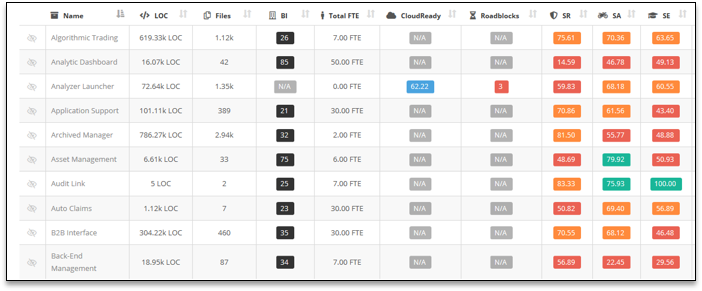Are you neck-deep in budget planning and building a business case for IT modernization? Do you have IT modernization projects that just can’t seem to get funded? Well, most IT leaders have the same problem. Gartner predicts that by 2023, 90% of current applications will still be in use, but most will have received insufficient modernization investment. This is primarily due to the business stakeholders not buying into the modernization business cases from IT. As you know, failure to create a compelling business case for IT modernization allows technical debt to accumulate, leading to business paralysis.
This is precisely the topic that I along with Lev Lesokhin of CAST covered on a recent webinar, “How to budget for IT Modernization”. We discussed how to frame a compelling business case for IT modernization budgets, and how to go about presenting the same. Here are the key takeaways.
Business Case for IT Modernization - Key considerations
-
Always lead with business impact.
Chris tells us that too many IT leaders are so focused on technology and the tasks required to execute an IT modernization project, that they often forget to connect their proposal to business impact. To make your budget proposal a success, you must start with what the business will gain: improved productivity, easier access to data and analytics, stronger ability to gain revenue, better retention of customers, and so on. -
Defend the strategy, not the numbers.
It is inevitable (and good business) that executives and the CFO office will question new budget proposals. However, many IT leaders tend to focus on the number of dollars or person-hours needed to complete a project rather than the larger strategy. By making sure that the enterprise is aligned to your strategy, may it be a legacy reduction or cloud migration, you shift the conversation from what the project needs to what the project can contribute to the firm. -
If you have to defend the numbers, focus on return on investment (ROI).
By focusing on the ROI, or the quantification of the gain by executing the project, IT leaders can shift the conversation to upsides and help the rest of the organization envision what success looks like. When discussing ROI, make sure you include the timing of the financial impact (e.g. when can the firm expect the savings or revenue lift?), any customer expectations (e.g. key customer XYZ has been asking an enhancement and this project would deliver it), and what is the cost of not acting (e.g. if we don’t modernize legacy application ABC, support and infrastructure costs will double in one year). -
Frame the need for the IT modernization budget as replace, merge, or re-engineer.
IT Modernization projects typically fall under three (3) categories: replace an existing technology with a new one (e.g. switching your CRM vendor), merge several applications or technology together (e.g. consolidate five geographically diverse HR systems into one), or re-engineer an existing application (e.g. convert a 30-year old legacy monolithic application into a service-oriented cloud-based application). By framing your modernization project into the three categories, IT leaders can better match the business drivers behind the project.
[Suggested reading: Driving Low-Risk Legacy Modernization- The spectrum of options] -
Replacement projects are driven by business capabilities and a weak sustainability outlook.
When a current piece of technology limits IT’s ability to deliver business enabling functions, it’s time to look for alternatives. Most leadership in your firm will have a hard time arguing against business enablement. Other drivers that can help in making the replacement business include sustainability (difficult to main or current vendor is weak), and having an imminent end of support or life. -
Merge projects are driven by business capabilities and simplification.
Modernization by merging applications or functions together is also largely driven by business capability limits. Plus, there is also a simplification factor. If the merging project will reduce the complexity of infrastructure or technical support, there is worthwhile business case there. Of course, other factors such as having a stronger target application already in place will also help. -
Re-engineering projects are driven by sustainability, competitive advantage via intellectual property, and technology evolution.
Re-engineering projects can be painful, so the drivers will be a bit different. A firm can gain a competitive advantage from re-engineering an application that strengthens its proprietary know-how, better leverages its talent, and further propels its technology advantage away from its competitors. A valuable piece of legacy technology is difficult to sunset, and therefore, re-engineering is typically the right path. -
Be prepared with the whole picture of the project.
An IT modernization project will have lasting effects beyond its implementation. Be sure to document aspects during implementation and post-project such as change management, knowledge transfer, platform, integration, and phase out. By detailing these related components, the proposal will be more robust and thorough. -
Don’t forget to include staffing considerations.
Discuss how staffing will change after a modernization project. Will team members need to be retrained, or will new staff need to be hired to manage the new technology? Perhaps, there is a need to collaborate with experts or vendors in order to deliver the project. Also, how will the project manage the phasing-in and out of different roles (e.g. developers, architects, and project managers)? -
And, of course, talk about Cloud.
Since every major modernization project should have a Cloud component, don’t forget to include details about it. What kind of cloud format will be used: IaaS, PaaS, or SaaS? Do think through the entry and exit costs. A deployment that will get the firm locked into a vendor for a long time may not be very attractive.
I hope these 10 IT modernization budgeting tips will help you make the budgeting season more productive. One last but most important consideration for you is to use facts when building your business case for IT modernization, and I will point you to the experts at CAST to help you with that!
Below are a few examples of objective facts and insights that CAST can provide to help you with your IT budgeting and business case for modernization.
Portfolio view of all applications – for rationalization strategy

Tracking and proving transformation success per unit cost measure
![]()
Comparing efficiency across teams and vendors

To find out how CAST has helped enterprise customers document and make the business case for their IT modernization budget proposals, connect with an expert for a walk-thru!







SHARE